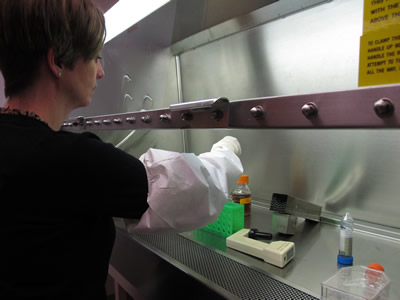Pacific Northwest Agricultural Safety & Health Center
Affiliate Document Repository (Login required) | For access to repository: nanotox@uw.edu
Research
Quantum Dots, In Vitro, In Vivo, Integrative Risk Assessment, Nanomaterial Synthesis and Characterization
Researchers conduct in vivo, in vitro, and risk assessment investigations to further models and tools that assess and predict both toxicity and the environmental impact of Engineered Nanomaterials. Research areas encompass a range of ENMs, as agreed upon by the NCNHIR consortium, and a center specialization in Quantum dots (Qdots).
The Center collaborates within a network of research centers at the University of Washington, including the UW Center for Nanotechnology, the UW Center for Lung Biology, and the UW Center for Ecogenetics & Environmental Health.
Quantum Dots
The Center specializes in the study of semiconductor quantum dots (Qdots), a subset of nanoparticles used in leading edge medical imaging and optoelectronics. Center researchers use custom-designed Qdots, modified with respect to their core composition, surface charge, size, and method of manufacture to examine the relationships between the different physical and chemical properties and other quantitative measures of toxicity.
In Vitro
Using systems genetics technology, Center researchers investigate gene expression changes to further define which genes are responsible for susceptibility or resistance to Qdots and other ENMs. Qdots are tested in vitro utilizing a variety of human and mouse cells, both primary and established lines, to examine their potential toxicity. This research aims to correlate the physical and chemical characteristics of ENMs with quantitative measures of cytotoxicity.
Such measures include ENM uptake and persistence, cell viability, mitochondrial function, redox status, oxidative stress, wound healing responses, and other functional endpoints. Cell lines to be tested include macrophages, hepatocytes, kidney proximal tubular cells, bronchoalveolar epithelial cells, vascular endothelial cells, cerebellar granular cells, and colonocytes.

In Vivo
Researchers expose mice of various genetic backgrounds, including genetically susceptible models, to ENMs and characterize absorption, distribution, metabolism, elimination, and toxicity (ADMET), as well as map toxicity pathways using multiple genetically defined inbred mouse strains.
Researchers use histopathology of the lung, heart, liver, spleen, thymus, lymph nodes, kidney, brain, testis, and conceptus (pregnant female mice). Studies are conducted with technologies that include inflammatory cytokine bead arrays, stress signaling bead arrays, global gene expression analysis, and epigenetic profiling using ChIPSeq and DNAse hypersensitivity site analyses. These toxicity profile data are used to correlate the physical/chemical characteristics of the test materials to inform integrated, systems-based approaches for linking predictive models of risk.
Integrative Risk Assessment
The Center investigates integrated, systems-based approaches for linking predictive models of risk for ENMs. The models are applied and based on data generated from examinations in vivo and in vitro assessments conducted by the Center and NCNHIR consortium members.
Nanomaterial Synthesis and Characterization
The center provides nanoparticle synthesis, modification, purification, and characterization for its research projects and Consortium-wide efforts. Dr. Xiaohu Gao’s Bioengineering lab and Dr. François Baneyx BioNano lab have developed a variety of techniques to derivatize Qdot surfaces and methods for biomineralizaton of Qdots. The synthesis and surface medication capabilities of both labs provide a rich set of core and surface compositions for Center studies.

